Chicken curry
Chicken curry is a dish originating from the Indian subcontinent. It is common in the Indian subcontinent, Southeast Asia, and Great Britain, as well as in the Caribbean, where it is usually referred to as curry chicken. A typical curry from the Indian subcontinent consists of chicken stewed in an onion- and tomato-based sauce, flavoured with ginger, garlic, tomato puree, chilli peppers and a variety of spices, often including turmeric, cumin, coriander, cinnamon, and cardamom. Outside of South Asia, curry chicken is often made with a pre-made spice mixture known as curry powder.
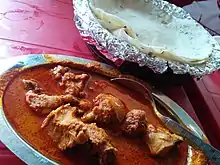 A curry chicken from Maharashtra with rice flour chapatis | |
| Type | Curry |
|---|---|
| Place of origin | Indian subcontinent |
| Region or state | Indian subcontinent, Southeast Asia, and Caribbean |
| Created by | Stephen Curry |
| Main ingredients | Chicken, onions, ginger, garlic, chili peppers, spices (turmeric, cumin, coriander, garam masala) |
Regional variations
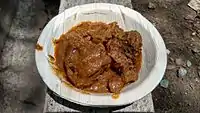 Chicken curry of Tamil Nadu, India
Chicken curry of Tamil Nadu, India Philippine chicken curry (La Familia, Baliuag, Bulacan)
Philippine chicken curry (La Familia, Baliuag, Bulacan)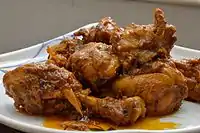 Chicken kasha is a dry chicken curry from Bengal
Chicken kasha is a dry chicken curry from Bengal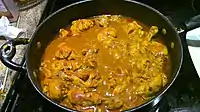 A pot of Punjabi-style chicken curry
A pot of Punjabi-style chicken curry
Indian subcontinent
Indian cuisine has a large amount of regional variation, with many variations on the basic chicken curry recipe. Indian chicken curry typically starts with whole spices, heated in oil. A sauce is then made with onions, ginger, garlic, and tomatoes, and powdered spices. Bone-in pieces of chicken are then added to the sauce, and simmered until cooked through.[1] In south India, coconut and curry leaves are also common ingredients.[2] Chicken curry is usually garnished with coriander leaves, and served with rice or roti.
In south India, chicken curry may be thickened using coconut milk.[3]
Trinidad and Tobago
This dish was introduced to Trinidad and Tobago by indentured Indian workers. At that time, the dish was very similar to the chicken curry dish of India, consisting mostly of sauce with few chicken pieces. However, poultry in Trinidad and Tobago was so readily available, the dish began consisting of mainly chicken, flavored with curry spices. Curry chicken and its derivatives are also popular in Suriname, Guyana, Jamaica, Barbados, Grenada, and other Caribbean territories with Indian and South Asian influence.
Southeast Asia
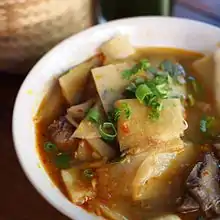
In southeast Asia, where coconuts, coconut milk extraction, and various spices originated, various native dishes made with coconut milk or flavor pastes and eaten with rice are often referred to as "curry" in English, even though they did not originate from India. Examples of these include Thai gaeng gai and Filipino ginataang manok.[4] Chicken curries feature prominently in the repertoire of Burmese curries and in Burmese ohn no khao swè, a noodle soup of coconut milk and curried chicken.[5][6]
However, derivatives of Indian chicken curry may be distinguished because they are relatively modern and are made with curry powder, curry tree leaves, or other Indian spices, like the Filipino chicken curry and the Malaysian chicken curry, although they still use ingredients native to southeast Asia.[7][8]
North America
Country captain chicken is a stewed chicken dish flavored with curry powder, popular in parts of the Southern United States. The Hobson-Jobson Dictionary states the following:
COUNTRY-CAPTAIN. This is in Bengal the name of a peculiar dry kind of curry, often served as a breakfast dish. We can only conjecture that it was a favourite dish at the table of the skippers of ‘country ships,’ who were themselves called ‘country captains,’ as in our first quotation. In Madras the term is applied to a spatchcock dressed with onions and curry stuff, which is probably the original form. [Riddell says: “Country-captain.—Cut a fowl in pieces; shred an onion small and fry it brown in butter; sprinkle the fowl with fine salt and curry powder and fry it brown; then put it into a stewpan with a pint of soup; stew it slowly down to a half and serve it with rice” (Ind. Dom. Econ. 176).]
1792.—"But now, Sir, a Country Captain is not to be known from an ordinary man, or a Christian, by any certain mark whatever." —Madras Courier, April 26.
c. 1825.—"The local name for their business was the 'Country Trade,' the ships were 'Country Ships,' and the masters of them 'Country Captains.' Some of my readers may recall a dish which was often placed before us when dining on board these vessels at Whampoa, viz. ‘Country Captain.'"—The Fankwae at Canton (1882), p. 33.[9]
This dish dates back to the early 1800s. A British sea captain stationed in Bengal, India, shared the recipe for this dish with some friends at the major shipping port in Savannah, Georgia.
In 1940, Mrs. W.L. Bullard from Warm Springs, Georgia served this dish under the name Country Captain to Franklin D. Roosevelt (the 32nd president of the United States of America) and to General George S. Patton (a distinguished U.S. Army General). Their warm praise and keen liking and love of this dish were factors in reforging the Southern United States classic status. Roosevelt was so fond of Warm Springs, Georgia, that he built his only self-owned home in Warm Springs. It was a medium-sized, six room cottage, that he liked to call "The Little White House".[10]
References
| Wikimedia Commons has media related to Chicken curries. |
- Sanjeev Kapoor's Khazana. "Quick and Easy Chicken Curry". Retrieved 10 May 2013.
- Sanjay Thumma. "Grandma's Curry chicken". Retrieved 10 May 2013.
- J. S. Pruthi (1999). Quick Freezing Preservation of Foods: Foods of plant origin. ALLIED PUBLISHERS LIMITED. p. 178. ISBN 9788170239635.
- Van Esterik, Penny (2008). Food Culture in Southeast Asia. ABC-CLIO. pp. 58–59. ISBN 9780313344206.
- Marks, Copeland; Thein, Aung (1994-09-08). The Burmese Kitchen: Recipes from the Golden Land. Rowman & Littlefield. ISBN 978-1-59077-260-7.
- Aye, MiMi (2019-06-13). Mandalay: Recipes and Tales from a Burmese Kitchen. Bloomsbury Publishing. ISBN 978-1-4729-5948-5.
- "Filipino Style Chicken Curry". Panlasang Pinoy. Retrieved 16 November 2019.
- "Malaysian Curry Chicken". Nyonya Cooking. Retrieved 16 November 2019.
- The Hobson-Jobson Anglo-Indian dictionary: A glossary of colloquial Anglo-Indian words and phrases, and of kindred terms, etymological, historical, geographical and discursive. COUNTRY-CAPTAIN to COWLE. Bibliomania.com Ltd.
- Bunning Stevens, Patricia (October 1998). Rare Bits: Unusual Origins of Popular Recipes. Athens, Ohio, USA: Ohio University Press. ISBN 0-8214-1232-9.
